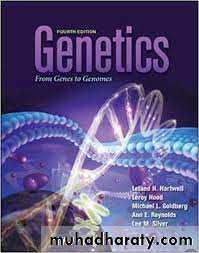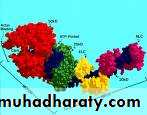Genetics Lec 1
Dr. Minen Al-KafajyApril 27-2021
Genetic
What is genetics?“Genetics is the study of heredity, the process in which a parent passes certain genes onto their children.”
What does that mean?
Children inherit their biological parents’ genes that express specific traits, such as some physical characteristics, natural talents, and genetic disorders.
Genetics concepts
Heredity describes how some traits are passed from parents to their children.The traits are expressed by genes, which are small sections of DNA that are coded for specific traits.
Chromosomes
Genes are found on chromosomes.
Humans have two sets of 23 chromosomes—one set from each parent.Background: What is DNA?
Deoxyribonucleic acidBlueprint that carries genetic information from one generation to the next
Resides in cell nucleus
DNA contains genes
Each gene is responsible for the production of a particular protein
A strand of DNA is a chromosome
Set of chromosomes carried by an organism is a genome
DNA Structure
Double helixDNA consists of four nucleotides: adenine, cyostine, guanine, thymine (A, C, G, T)
5 prime (beginning), 3 prime (end)
Base Pairs: A-T, C-G
Ordering of these pairs is a sequence
An example:
G A A T T C
C
T
T
A
A
G
DNA Structure
Example Genome Sizes
• Species• Number of base pairs
• Number of genes
• E. coli
• 4,600,000
• 3200
• Fruit fly
• 180,000,000
• 13,600
• Chicken
• 1,000,000,000
• 23,000
• Mouse
• 2,500,000,000
• 30,000
• Corn
• 2,500,000,000
• 59,000
• Human
• 3,000,000,000
• 25,000-30,000
• Grasshopper
• 180,000,000,000
• ?
• Amoeba
• 670,000,000,000
• ?
Why so many base pairs?
“Junk” DNA (or non-coding DNA)
Portions of DNA sequence for which no function identified
98.5% of human genome
Recently, scientist found that non-coding DNA is important in regulation
Why is DNA useful?
Every living thing on earth uses DNA to store and transmit informationCatalogs all the different functions performed in an organism
Identify similarities among organisms
Identify inherited traits
Solving crimes
DNA replication
DNA molecule splits, each half gets copiedWhy is DNA double stranded?
More stable
Replication consists of half-new, half old
Allows for error-correction
If a base is damaged, can correct
Like a RAID
RNA
Transcription – copy DNA into RNA
Only genes get transcribedPromoter – DNA sequence that enables gene to be transcribed
Exon – protein coding sequence of gene
Intron – sections of DNA that are spliced out after transcription
Messenger RNA (mRNA) moves out of cell nucleus to provide building plans for proteins
RNA alphabet: Uracil (U) instead of thymin (T)
Proteins
Buildings” and “machines” inside cellComposed of amino acids
Analogy: DNA and RNA send and store information, proteins make things happen
Can fold into shapes dependent on their amino acid sequences
Protein Examples
Collagen – shaped like a rod
to be used as structural
support
Myosin – has a hook that can
be used as a motor
Found in muscles
Protein alphabet
20 symbols (20 amino acids)Genetic code – Ribosome reads mRNA and writes protein, 3 at a time
Each 3 letter RNA sequence translates to one of 20 symbols
Degenerate – 4^3 = 64 combinations – but only 20 symbols
Redundancy






